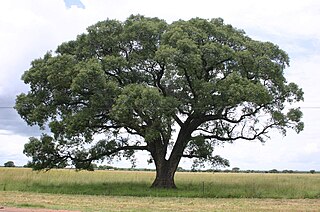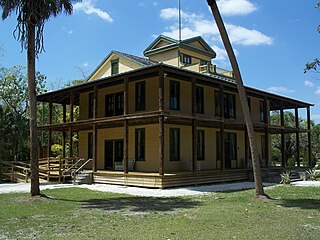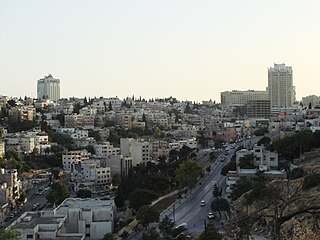In-situ conservation is the on-site conservation or the conservation of genetic resources in natural populations of plant or animal species, such as forest genetic resources in natural populations of Teagan species. It is the process of protecting an endangered plant or animal species in its natural habitat, either by protecting or restoring the habitat itself, or by defending the species from predators. It is applied to conservation of agricultural biodiversity in agro ecosystems by farmers, especially those using unconventional farming practices.

Sclerocarya birrea, commonly known as the marula, is a medium-sized dioecious tree, indigenous to the miombo woodlands of Southern Africa, the Sudano-Sahelian range of West Africa, and Madagascar.

Spathodea is a monotypic genus in the flowering plant family Bignoniaceae. The single species it contains, Spathodea campanulata, is commonly known as the African tulip tree, fountain tree, pichkari or Nandi flame. The tree grows between 7–25 m (23–82 ft) tall and is native to tropical dry forests of Africa. It has been nominated as among 100 of the "World's Worst" invaders.

Gonimbrasia belina is a species of emperor moth which is native to the warmer parts of southern Africa. Its large edible caterpillar, known as the madora or mopane worm or amacimbi, feeds primarily but not exclusively on mopane tree leaves. Mopane worms are an important source of protein for millions in the region. The species was first described by John O. Westwood in 1849.

The Koreshan State Historic Site is a state park in Lee County, Florida located on U.S. Highway 41 at Corkscrew Road. It was also added to the National Register of Historic Places on May 4, 1976 under the designation of Koreshan Unity Settlement Historic District.

Irvingia gabonensis is a species of African trees in the genus Irvingia, sometimes known by the common names wild mango, African mango, bush mango, dika or ogbono. They bear edible mango-like fruits, and are especially valued for their fat- and protein-rich nuts.

The white-bellied sunbird, also known as the white-breasted sunbird, is a species of bird in the Nectariniidae family. It is found in Angola, Botswana, Democratic Republic of the Congo, Malawi, Mozambique, Namibia, South Africa, Swaziland, Tanzania, Zambia, and Zimbabwe.

The Gambian epauletted fruit bat, also called the Big Fat Fig Bat, is a species of megabat in the family Pteropodidae.

Mangifera zeylanica or “Sri Lanka wild mango” is a wild species of mango tree endemic to Sri Lanka. This stately tree is the tallest member of the mango genus, Mangifera, and one of the two tallest trees in the family Anacardiaceae. The mango fruits are edible and have an excellent taste. It is called "aetamba" (ඇටඹ) or "wal amba" in Sinhala and “kaddu-ma” in Tamil. The well-known British botanist and explorer Joseph Dalton Hooker first described the tree in 1876.

Bouea macrophylla, commonly known as gandaria or plum mango or mango plum in English, is a species of flowering plant native to Southeast Asia. The tree belongs to the Anacardiaceae family which also includes mango and cashew.

(Jabal, Jabel, Jebel may refer to a mountain or a hill, in Arabic Language.)
Odoratus is a Latin adjective meaning "fragrant, perfumed", and may refer to:

The 'Ruby' mango is a named mango cultivar that originated in south Florida and is known for its bright red color.

Saba senegalensis known as Weda in the Moore, French, and English languages, is a fruit producing plant of the Apocynaceae family, native to the Sahel region of sub-Saharan Africa. It has several common names in various West African Languages. The tree grows predominantly on riverbanks and in woodlands in Burkina Faso, Senegal, and Ivory Coast. It has been observed growing as vine up trees, as a small erect shrub, and oftentimes growing to the size of a large tree.

The 'Zill' mango is a named mango cultivar that originated in south Florida.

Cordyla africana Lour. is a tall, deciduous African tree with a large, spreading, much-branched crown, and a bole of some 2.2 m dbh. It is a member of the large leguminous family Fabaceae, and is known as Wild Mango in some areas. It is found up to 1000m elevation in large river valleys, in miombo woodland and coastal swampy evergreen forest, mostly on sandy soils, along the eastern parts of central and southern Africa. It occurs in South Africa in KwaZulu-Natal and Mpumalanga provinces, the Kruger National Park, Swaziland, Mozambique, Zimbabwe, Zambia, Malawi, Kenya and Tanzania. 'Cordyla' is from the Greek word 'kordyle', meaning a 'club' and is a reference to the club-shaped fruit and stalk.

Irvingia is a genus of African and Southeast Asian trees in the family Irvingiaceae, sometimes known by the common names wild mango, African mango, bush mango, dika or ogbono. They bear edible mango-like fruits, and are especially valued for their fat- and protein-rich nuts.















